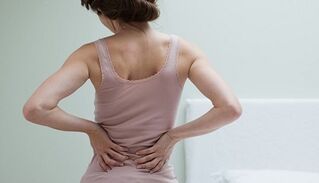
Around 80 percent of adults suffer from back pain. When you have a problem too, you know you are not alone. This is repairable. The main thing is to understand the origin of the pain, but there can be many factors. We've rounded up the main causes of back pain that can cause back problems. How can illness be alleviated? There are ways.
Back pain can occur at any age and with any level of physical fitness. So there is dull, constant, or intermittent pain and a sudden acute attack after which it is difficult for a person to move. Pain can be sudden from heavy lifting, develop with age due to changes in the spine or as a result of an accident. A sedentary lifestyle is also a major cause of back pain. Especially when everyday life is not impaired by physical activity (training, swimming pool, fitness, yoga).
In most cases, lower back pain is acute and short-term or less severe, but lasts a few days to a few weeks. In such cases, a person still does not lose activity, the ability to move and use himself in everyday life.
Subacute pain is pain that persists after an acute period and lasts for 4 to 12 weeks. If the pain persists after this time, it is called chronic. Sometimes treatment can help relieve chronic lower back pain. However, in some cases, the pain persists despite medical and surgical treatment.
In other words, back pain, the causes of which are often age-related and are associated with wear and tear of the joints, intervertebral discs and bones of the spine or mechanical pain:
1st sprains
This can lead to severe back pain. Stretching occurs when something is not rotated or lifted properly. And also from heavy lifting or excessive stretching. These conditions can cause spasms in the back muscles, which also cause pain.
2. Wear of the intervertebral disc

One of the most common causes of back pain. A manifestation of this is the loss of the hard drive integrity, cracks appear. For a young and healthy back, the discs allow the lower part to bend, loosen and twist. Over the years, the elasticity of the discs decreases and they lose their shock absorption capacity.
3rd hernia
It may occur due to lifting a large load, poor posture, accident, sports injury, etc. There is fluid in the center of the disc, which for various reasons can leak and irritate the nearby nerve root. There are many nerve fibers in the disc wall, and a torn wall can cause severe pain.
4. Radiculopathy
This condition occurs due to compression, inflammation, and / or damage to the spine root. In addition, pressure on a nerve root causes pain, numbness, or tingling sensation that spreads to other parts of the body that are connected to that nerve. The problem can occur when the central spinal canal narrows or an inguinal hernia pinches the nerve root.
5. Sciatica
Compression of the sciatic nerve, which moves through the buttocks and extends across the back of the leg. This compression causes shock or burning pain in the lower back, combined with pain in the buttocks. And even in exceptional cases, when the nerve becomes pinched between the intervertebral disc and the adjacent bone, a person may feel numbness and severe weakness in the legs. By the way, this condition occurs due to a tumor or cyst that is pressing on the sciatic nerve or its roots.
6. Stenosis of the spine
With this disease, in addition to lower back pain, a person may experience numbness or weakness in their legs when walking. And also with loss of sensitivity.
7. Scoliosis and other skeletal disorders

A person usually doesn't have any particular problems with the curvature of the spine until middle age.
Lower back pain isn't often associated with serious medical conditions. However, you need to be aware of their existence in order to have time to consult a doctor in a timely manner. Fighting the diseases listed below is only possible with medical help. This:
1. Infections
These are not causes of back pain, but can affect vertebrae (osteomyelitis), intervertebral discs (discitis) or sacroiliac joints (sacroiliitis).
2. Tumors
Sometimes a tumor appears in the back (and at certain stages, of course, there is pain and other symptoms), but most of the time it is metastasis that has spread to other parts of the body due to cancer.
3. Cauda Equina Syndrome
Disease that is sometimes accompanied by a ruptured disc. This is because the disc material is pushed into the spinal canal, compressing the bundle of the roots of the lumbar and sacral nerves. Associated with this disease, a person can have problems with urination and bowel movements.
4. Abdominal aortic aneurysm
This occurs when a large blood vessel that supplies blood to the abdomen, pelvis, and legs becomes abnormally dilated. Additionally, lower back pain can be a signal that the aorta has enlarged and is in danger of rupture.
5. Kidney stones
Stones can cause severe lower back pain (usually on one side).
Other factors and causes that can cause back pain:
- Inflammatory diseases of the joints.For example arthritis, spondylitis, vertebral body inflammation.
- osteoporosis.This is a bone disease that is associated with a decrease in bone density and strength and can lead to vertebral body fractures.
- Endometriosis.A female disease that can be accompanied by pain in the pelvis and lower back.
- fibromyalgia.Pain syndrome accompanied by muscle pain and fatigue. It's chronic.

What to do with back pain?
First of all, you need to have a good understanding of the causes of pain. What can help one disease will not do (and maybe even worsen) another. In some cases, urgent hospitalization is required. It is therefore imperative that you pay attention to the signals from the body and, if necessary, consult a doctor or take appropriate measures.
Ways to deal with lower back pain:
1. You can give your back a break after a certain period of time
Many back problems can be solved (or alleviated) by avoiding strenuous activity. However, it is not recommended to rest for more than a few days, as inactivity for too long can make treatment difficult.
2. Limited activity
This means staying active but avoiding actions and attitudes that make the pain worse. For example, if prolonged periods of time in the car or at a desk make the pain worse, set a timer to get up and walk or stretch gently every 20 minutes. Minimizing actions and positions that make the pain worse will help prevent or relieve painful cramps and speed up the healing process.
3. Cold / heat therapy
A warm bath, heating pad and body pack are suitable for relaxing tense muscles and improving blood circulation. If inflammation is causing your back pain, you can try using ice or cold compresses to reduce swelling. It is important to protect the skin during the procedure to avoid tissue damage.
4. Painkillers
The most common over-the-counter medications are anti-inflammatory drugs that relieve back pain caused by swollen nerves or muscles. In some cases, an analgesic can also help. B vitamins, muscle relaxants, various gels and ointments are effective.
5. Physiotherapy
Usually part of the treatment of back pain. Stretching is helpful: the more flexible the muscles are, the better the back can move without injury. It is recommended to start small - stretch the muscles of your lower back, buttocks, thighs, and legs for 20-30 seconds, and stop stretching if it hurts.
You also need to strengthen the muscles in your stomach, thighs, and buttocks that support your spine. Low impact aerobic exercise increases blood flow and promotes injury healing without spinal tremors. For example, you can exercise, run and swim on stationary bikes and elliptical trainers.
In fact, any exercise that keeps the cardiac cycle healthy for a long time is beneficial to the body. Regular physical activity is important to maintain the freedom of movement and flexibility of a healthy spine.














































